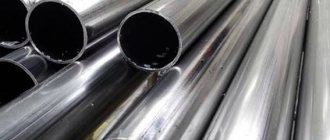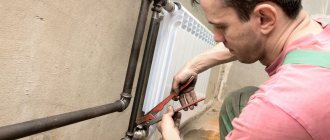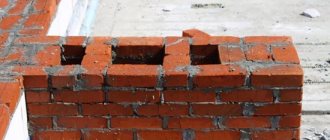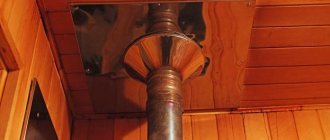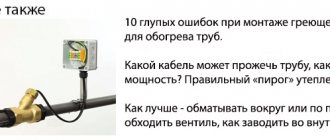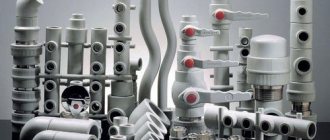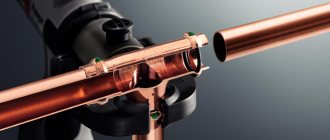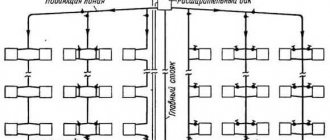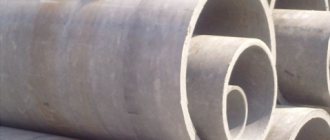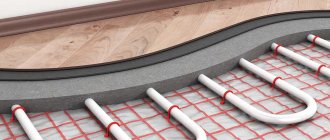When do you need to change pipes?
The most common reason for replacing pipes is the low resistance of cast iron and steel types to corrosion. Over time, they wear out, which leads to leaks. Over the years of operation, a layer of deposits accumulates on the inner surface of the pipes, which reduces the efficiency of the entire system, since less coolant flows into it. When radiators are clogged with rust, they stop heating, although the riser remains hot.
Replacement is made when, due to an error in the design, the heating of the room is connected through the “return”, so it is cold there. The inability to bleed air from the pipes leads to cooling of the radiators and noise in the riser. Old heating systems did not provide for the installation of taps to shut off the pipes in each room. Therefore, in emergency cases, it is necessary to turn off the heating riser of the entire entrance.
Why do you need to replace old water pipes?
In addition to pure H2O, a huge amount of impurities pass through the water supply every second, which tend to settle on the inner surface of the pipes. Over time, the lines become clogged with particles of oxidized metal, which leads to corrosion. In addition, the appearance of old Soviet metal pipes is not at all in harmony with the modern interior of the apartment. Sooner or later, almost all owners of old apartments come to mind one simple thought - the pipes need to be changed.
Cost of replacing water pipes with plastic ones
At the moment, the most popular pipes are made of polypropylene, metal-plastic (so-called “reinforced pipes”), or polyethylene. The price for them differs not only depending on the material, but also depending on the region of residence.
So, the price per meter of a propylene pipe with a diameter of 100 mm will be 500-600 rubles, a reinforced pipe with the same characteristics will cost 1300-1600, and the cost of a polyethylene pipe will be around 300-500 rubles.
To determine the price of a new water supply system, take a diagram, calculate the total length of the pipes, add 15% - just in case, add the cost of fittings and fasteners and... voila - you will have the cost of all elements and installation of the main in your hands.
Advantages of plastic water pipes
Firstly, plastic does not rust, which makes it much more durable and safer than Soviet-era metal water pipes.
Secondly, it does not have a fragile internal coating, which again extends its service life and maintains the purity of the water even after a couple of decades of operation.
Thirdly, it is more reliable, as it can be easily soldered and is resistant to temperature changes. So, if you don’t know what to choose – metal or plastic – feel free to buy polymer.
Frequency of replacement of water supply pipes
There is no clear answer to this question, but using a statistical survey, the result was obtained “once every 30-40 years if it is plastic and once every 20 years if it is metal.” Due to the high wear rate of the latter, the water supply system becomes unusable faster. On the other hand, if the pipes are outwardly in good condition, and the pressure and purity of the water in them correspond to your understanding of the norm, you can postpone replacement.
As the saying goes, “don’t break what still works.” But if troubles appear ahead of schedule, they need to be replaced, and quite urgently, since problems with pipes can have catastrophic consequences. In addition, it is recommended to immediately change the entire system - simply because the method of joining plastic with metal is still not as reliable as joining two identical materials that can be securely fastened in many different ways.
When is the best time to change the system?
The best time is summer. The pipes are empty, so you don’t have to worry about complaints from your neighbors next door. There is enough time to think through the project to the smallest detail, consult with specialists if necessary, go shopping and stock up on materials, and then slowly and carefully make the replacement. But you will be able to test it only at the beginning of the heating season. However, in emergency cases or when leaks begin to appear frequently, you will have to start replacing, regardless of the time of year.
Selection of materials
In order for the updated system to be effective and durable, you need to choose the right elements. The reliability of the system depends on the pipes, so when choosing, you need to pay special attention to them. If a leaking radiator is easy to quickly disconnect from the system, then due to a leak in the wiring, you will have to shut off the riser for a long time. When drawing up a project, you should take into account the installation of shut-off valves at radiators. Ball models are best suited for this, providing reliable overlap. Batteries are selected depending on operating pressure, coolant composition, and heat transfer efficiency.
Pipes
A variety of materials are used for their manufacture, each having its own advantages and disadvantages. Heating pipes must be:
- durable;
- durable;
- can withstand high pressure and withstand hydraulic shocks without damage;
- chemically inert;
- resistant to corrosion;
- withstand temperatures of at least 95 ⁰C;
- environmentally friendly;
- with a smooth inner surface that prevents the formation of plaque and does not create much resistance to the movement of the coolant.
In addition, they should be easy to install with the possibility of subsequent system upgrades. For example, to install another radiator or tap. Pipes made of the following materials meet the listed requirements:
- Stainless steel containing at least 20% chromium and nickel is not subject to corrosion and deposit accumulation. The service life is at least 50 years, but the high cost prevents widespread use.
- Ordinary carbon steel , despite its strength and low price, quickly rusts and becomes overgrown with salt deposits. Needs constant care and painting. It is not currently used for the installation of in-house systems, but is used for repairing old ones.
- Copper is durable (service life up to 100 years), chemically inert, and has bactericidal properties. High strength allows the use of thin-walled pipes in systems with high pressure. However, they have the highest price and complex installation. Therefore, copper pipes are rarely used for heating.
- Polypropylene - can last for half a century without succumbing to corrosion or becoming overgrown with salts. It has good strength, withstands high temperatures, and is inexpensive. Using a variety of fittings, systems of any complexity can be easily installed, but its sensitivity to ultraviolet radiation should be taken into account.
- Cross-linked polyethylene is not inferior to polypropylene in its basic characteristics, and even surpasses it in strength. With strong heating (above 95 ⁰C) it can change shape. Due to the higher price it is used less often.
- Metal-plastic pipes made of polypropylene - covered with aluminum foil. Therefore, their reliability is higher, but their flexibility is less. Other characteristics are the same.
- Corrugated stainless steel pipe bends very well, which makes it possible to install systems of complex configurations with a minimum number of connections. It holds pressure and temperature well, but can be damaged by an accidental blow, so protective covers should be installed after installation. Fittings require regular maintenance (tightening nuts, changing gaskets). In terms of price it ranks second after copper.
A good option for installation would be plastic and aluminum-reinforced pipes. They are inexpensive, and in basic parameters they are no worse than their metal counterparts. To protect stainless steel and copper products from stray currents, grounding is needed, but not every home has it. For private housing, the material is selected depending on preferences and financial capabilities.
Radiators
Without replacing the heating batteries, even very durable new risers will not ensure reliable operation of the system. The requirements for radiators are not as stringent as for communications, so when choosing, more attention is paid to the appearance and efficiency of heat transfer. The stores offer:
- Modern cast-iron radiators , unlike Soviet batteries, are compact, and models made in retro style look elegant. They are durable and do not corrode. However, the heavy weight makes installation difficult, and fragile cast iron can suffer from water hammer.
- Aluminum radiators are varied in design and inexpensive. In a private home, where the system is filled with purified water with normal acidity, they will last up to 20 years. The pH value of the coolant should not exceed 8; at a higher value, a chemical reaction occurs with the release of hydrogen. To release it, a crane will be installed. Based on the manufacturing method, extrusion and injection molding radiators are distinguished. The first ones consist of three compressed parts. The manifolds are injection molded and the middle is formed using an extruder. The second sections are made by injection molding, so their strength is higher.
- Bimetallic radiators - consist of steel or copper pipes, on top of which an aluminum shell is pressed, providing good heat transfer. Sectional and monolithic varieties are available. The first ones can be increased or reduced if necessary. The latter can withstand up to 100 atm, so they are installed in high-rise buildings with high-pressure heating systems, where water hammer is not uncommon. There are cheap options in which only the vertical tubes between the collectors are made of steel, and the other parts are made of aluminum. They have better heat transfer, but lower reliability.
- Steel radiators are inexpensive, weigh little, and have good heat transfer. The design is either panel or tubular. When manufacturing the first, two sheets with extruded grooves are welded through which the coolant will flow. The radiator is assembled from one or more such panels. Modifications with fins have higher thermal output, but dust accumulates on them, which is difficult to remove. Tubular models consist of two collectors connected to each other by vertical sections. They are more durable, but also more expensive.
Introduction to plastic pipes
What are the advantages of the material and are there any disadvantages? How can you be sure that the best choice is made? First things first.
Advantages and disadvantages
Why is replacing metal pipes with plastic ones a wise decision? The secret is in the special properties of this material.
Among the advantages are:
- duration of operation (up to 100 years depending on the type of structure);
- lightness of the material;
- immunity to corrosion;
- ease of installation;
- strength;
- noiselessness during network operation;
- elasticity;
- environmental friendliness (the chemical composition of the liquid moving through the system does not change);
- low thermal conductivity;
- versatility of the gasket (the material can be installed in both open and closed ways);
- ease of transportation;
- moderation in price.
There are a lot of advantages. Plastic is the most optimal material among its “brothers”. Networks made from it last a long time and do not cause trouble to the owners, of course, if the replacement of plastic pipes in the apartment was done correctly.
There are few disadvantages - just a few:
- restrictions on the temperature of transported substances (depending on the type of structure);
- selection of installation technology (they also vary and depend on the type of material);
- compatibility in composition (control to ensure that liquids that can corrode plastic are not transported through the network).
Types of plastic structures
Let's consider how to replace old ones with plastic pipes so that the disadvantages do not appear. During the production process of products, other substances are added to plastic, so you may find the following markings on purchased items:
- MP – metal-plastic. This “duo” of ingredients is said to be ideal for honing your home craftsmanship. The material does not fail either in the cold (withstands frosts very well) or when transporting liquids with high temperatures (up to 900 degrees). The only negative is sensitivity to external deformation. Bend such elements carefully.
- PE or polyethylene. The main advantage of this composition is that you can work with it at low temperatures, that is, even when it is -20˚ outside, you can carry out work on laying a polyethylene network or repair already installed communications. The main thing is to choose the right pressure threshold - low or high.
- PES, which means cross-linked polyethylene. Such material is used both for laying water supply lines and for heating networks. Why "stitched"? Simply, the technology of processing products under pressure, aimed at increasing the threshold of resistance to temperature changes and increasing stability, is called “stitching”. Elements are treated using nitrogen, silane gas, the peroxide method or irradiation of electron flows.
- PVC or polyvinyl chloride. If you see such a marking, do not buy the product if you plan to install a network for domestic use, since the composition contains chloride. Such material is suitable for arranging swimming pools and chemical plants, but not for the home.
- PP – polypropylene. This material is suitable for supplying water to housing. Thanks to a special device (3 layers - protective, plastic itself and foil), the products are resistant to temperature changes and can successfully transport liquids reaching temperatures of more than 1000 degrees. However, there are also disadvantages: low elasticity (products do not bend well), the impossibility of replacing elements (welding is used “forever”, so replacing a damaged section of a plastic pipe is impossible in this case).
Advantages and disadvantages of plastic pipes
Polymer products have a lot of advantages, among which it is worth highlighting:
- Long service life (modern plastic pipes can sometimes last about 100 years);
- Light weight of the material;
- Full resistance to corrosion;
- Ease of installation;
- Good strength properties;
- Good level of sound insulation;
- High elasticity;
- Environmental safety (plastic pipes do not change the chemical composition of transported water);
- Low degree of thermal conductivity;
- Versatility;
- Ease of transportation;
- Low cost.
The list of advantages looks impressive. The described qualities have provided plastic pipes with recognition and the title of one of the best materials for arranging any pipelines - it’s not just that old pipes are replaced with plastic ones in most houses and apartments.
Of course, plastic pipes also have disadvantages, but their list looks much more modest than the list of advantages:
- Polymer pipes have restrictions on the temperature of transported substances (specific values depend on the material);
- Variety of installation technologies (different technologies are used to install different types of plastic pipes);
- Susceptibility to certain types of alkalis and acids (when choosing pipes for transporting aggressive substances, you have to carefully study their characteristics).
Which plastic pipes to choose to replace the water supply
You can replace the pipeline in an apartment or house with plastic pipes made from the following materials: polypropylene, metal-plastic, and polyethylene. When choosing a material, it is important to consider not only their characteristics, but also their cost. The most expensive option is to use a metal-plastic pipeline, since the cost of one meter of a product with a diameter of 100 mm is about 1.5 thousand rubles. This cost is due to the design of the product. Polypropylene and polyethylene pipes are 2 times cheaper, so in most cases, owners decide on polypropylene.
When calculating the cost of a pipe, you must also take into account the price of connecting elements. These are elements such as fittings, fasteners, adapters.
Metal-plastic pipes
Metal-plastic pipe This is the most common option today.
This is explained simply - very easy and affordable installation, plus the inexpensive cost of materials. It turns out to be a kind of budget-home option. This pipe is a five-layer structure in which the outer and inner polyethylene layers are glued to an aluminum layer with adhesive layers. The result is a kind of sandwich that is easy to bend and assemble.
Advantages of a metal-plastic pipe:
- Easy to assemble. Repairing pipes in an apartment is like putting together a children's construction set.
- Pipeline cost. This is the most economical method of piping.
- Savings on workers' compensation. The amount saved is quite significant. You yourself are quite capable of assembling the entire pipe at the proper level, unless you change the valves at the entrance to the apartment with the help of professionals.
- You can always cut into a finished pipeline, and it won’t take much time.
Minuses:
- Over time, the connections will become loose and will need to be tightened. Therefore, such a pipe can only be hidden in the floor or walls if it is installed using press equipment.
- Quite low reliability. The joints may begin to leak as a result of water hammer or a large temperature difference.
Advice: when choosing a pipe, make sure that it does not flake and is seamless. Otherwise, you won’t have any hassle during installation.
There are a number of nuances in how to properly connect metal-plastic pipes:
- Cut the pipe with special scissors, which you hold strictly perpendicular to the pipe. Otherwise, an uneven cut will cause problems when tightening the fitting nut.
Cutting a metal-plastic pipe
- Calibrate the edge of the pipe with the nut and ring on to ensure an even calibration without distortion.
Pipe calibration
- Use a spring-loaded pipe bender whenever possible. A metal-plastic pipe bends very easily, but if the bend is significant, it can simply “fold.”
Classification of plastic pipes
There are several polymer-based materials. The final products differ in their composition and production technology, so before purchasing you need to study them in order to choose the best option.
The following types of plastic pipes are found on the market:
- Metal-plastic (MP) . This material is made, as the name suggests, of metal and plastic. This combination can withstand exposure to both low and high temperatures – certain types of metal-plastic pipes can operate at a carrier temperature of 900 degrees. The main disadvantage of this material is its low flexibility, so bending the pipes must be done very carefully.
- Polyethylene (PE) . Polyethylene pipes can be installed even at sub-zero temperatures, which is why they are often used for urgent repairs. When choosing PE pipes, you need to pay attention to the fact that it can be designed to work under conditions of either low or high pressure.
- Cross-linked polyethylene (PES) . This material is made under pressure using various additives, and the method of its production is called “cross-linking” - hence the name. Cross-linked polyethylene can be used both in water supply and heating systems - the characteristics allow the pipes to operate at a fairly high temperature.
- Polyvinyl chloride (PVC) . One of the components used for the production of PVC pipes is chloride, the effect of which on the human body cannot be called positive. Polyvinyl chloride pipes are not used when laying household pipelines.
- Polypropylene (PP) . Polypropylene pipes are the optimal material for laying water supply systems. The multilayer design provides such pipes with good strength and the ability to operate at high temperatures. Among the disadvantages, it is worth noting very poor elasticity and the inability to painlessly replace individual elements - the connection of polypropylene pipes is carried out by welding, so the damaged areas will have to be completely cut out.
We install polypropylene pipes
Pipe cutting is done with a special knife, which comes complete with a soldering iron.
Polypropylene pipes are mounted with a special soldering iron for polypropylene pipes.
Before soldering, the pipes must be cut to the required size and, if the pipes have an outer shell or reinforcement, they must be cleaned.
Pipe cutting is done with a special knife , which comes complete with a soldering iron. You can also use a regular hacksaw for metal.
The pipe and fitting are placed on opposite sides of the soldering iron and heated to a temperature of about 250 degrees. This takes about 20 seconds, after which the pipe must be quickly but carefully inserted into the fitting and left to cool.
When the connection has cooled, you can begin soldering the next connection.
A special adapter is used to connect the threaded valve to a polypropylene pipe. Thanks to this, there is no need to change the entire riser system in the house.
Pipes can be mounted along the wall, fixing them with special holders, or buried in pre-prepared grooves. If you remove pipes inside the walls, remember that taps, valves and other important elements must be easily accessible for repair and maintenance.
The grooves with the pipes hidden in them are sealed with cement or glue for ceramic tiles.
Copper pipes
Copper pipes were previously considered elite when there were no plastic pipelines.
Copper has a number of positive properties for which it continues to be praised to this day:
- The antibacterial effect of copper is well known, which is the main reason for its use.
- Thermal conductivity. Copper is an excellent heat transfer agent, allowing it to operate over a very wide temperature range, especially in the refrigeration industry. Copper does not become brittle at low temperatures.
- Reliability and aesthetics. Copper withstands high pressure, its linear expansion is minimal, i.e. it does not “play” when temperatures change.
- Copper is a natural, environmentally friendly material.
Replacement of water supply and heating system pipes with polypropylene
Installation of a new pipeline based on PP pipes can be done with minimal experience and a simple arsenal of tools.
First you need to draw up a diagram of the new engineering system and mark out the areas where the new pipes will run. You can navigate old pipes by measuring their length and drawing a wiring diagram on paper.
Before starting work, you should prepare the necessary equipment and materials, paying special attention to the type of pipes that will be used.
Tools required for work:
- grinder for cutting old metal pipes;
- special wrenches for twisting threaded connections;
- soldering machine for PP pipes (“iron”).
Depending on the engineering system to be modernized, you need to purchase the appropriate types of pipes. They differ in diameter and wall thickness, the presence/absence of a reinforcing layer, and the nominal temperature and pressure in the system.
Note! These parameters can be clarified with the housing office or management company (for an apartment building), or you can view the design of the engineering system (for a private house).
For the installation of heating systems, pipes reinforced with aluminum or fiberglass with a diameter of 20, 25 and 32 mm are used. The greater the length of the pipeline, the larger the cross-section of the pipe should be.
You can choose the right pipe by studying the markings on polypropylene products. It indicates the type of material, diameter and wall thickness, pipe class according to the nominal temperature and the maximum permissible operating pressure.
In addition to pipes, you need to buy the required number of coupling connections - fittings, as well as materials for sealing joints (fuel tape, oil seals, rubber seals - depending on the type of system).
It is necessary to note the installation locations of new radiators (usually old cast iron batteries are replaced with new aluminum or bimetallic ones).
To connect pipes and fittings made of polypropylene, a special soldering apparatus is used to weld pipes by heating.
Do not forget about tools for cutting pipes - special scissors, as well as liquid for degreasing pipes before soldering.
Important! Before starting work, you must make sure that the water in the system is shut off. In apartment buildings, any pipe replacement work affects communications in neighbors’ apartments on the top and bottom floors. It is advisable to warn them about temporary inconveniences, or notify the housing office of the need to shut off the water along the riser.
Dismantling old pipes
Having drained the water from the system, you can begin to dismantle the old elements of the system - plumbing fixtures (if necessary), heating radiators.
Water is drained from the battery through a special valve. As a rule, an old cast-iron battery can no longer be repaired; it must be thrown away and replaced with a new type of radiator - bimetallic, steel or aluminum. After dismantling the battery, the old metal pipes are cut with a grinder 3-5 cm from the ceiling and floor. After cutting the pipe, you need to put adapters in its place.
Preparation for installation of PP pipes
Pre-purchased polypropylene pipes must be cut in accordance with the pipeline installation diagram. This must be done with special scissors (sold in hardware stores).
Attention! When replacing pipes in heating systems with polypropylene ones, it is necessary to take into account thermal expansion. When heated, such pipes tend to increase in length by 1.5-1.7 cm. This figure must be added to the estimated length of the pipeline, and also care must be taken to movably fix the pipes along the walls.
Fittings for polypropylene and connections to metal pipes
To connect pipes to each other, special transition elements - fittings - are used. They are products made of polypropylene, as well as combined models made of polypropylene with a metal liner.
We recommend that you read: Is metal-plastic or polypropylene better for plumbing?
Fittings with internal metal threads are used to connect PP pipes with metal elements - pipes, adapters, ball valves.
To replace engineering systems, several main types of fittings are used:
- coupling - used for connecting in a straight section, as well as for connecting two pipes of different diameters;
- angular (angles) - needed to connect pipes at right angles for installation in places where the pipeline turns;
- tees - fittings for wiring (for example, to create a branch for introducing a hose from a washing machine to the sewer).
For PP pipes, it is necessary to use special fasteners - plastic brackets that are screwed to the wall using self-tapping screws. Their diameter must match the diameter of the pipes.
Attention! On pipe sections near the wall or in the corner of the room, it is necessary to use special movable fasteners to ensure free movement of pipes during linear expansion. It is necessary to leave a gap near the walls and especially in the corners.
Replacement of plumbing pipes
Before installing PP pipes, they must be marked for cutting and soldering with fittings in accordance with the length of the pipeline section in the diagram.
When marking, it is necessary to provide for installation locations for new heating radiators, as well as entry points for washing machine/dishwasher hoses, connections for the tank, washbasin, sink, bathtub, shower cabin, main filters and other elements of the system. The batteries can be placed in place of the old ones, or you can choose a different place for them.
Before starting work, you need to take care of special fastenings for the battery - brackets.
When the new polypropylene pipes are cut in accordance with the pipeline diagram, welding can begin.
- The soldering machine for PP pipes heats up to 260°C together with Teflon nozzles, whose diameter corresponds to the diameter of the pipe and coupling.
- The end of the pipe and fitting is pre-cleaned and degreased.
- The fitting and the end of the pipe are simultaneously placed on Teflon nozzles and heated for 5-7 seconds.
- Both pipeline elements are removed from the soldering iron and immediately connected to each other with a precise and neat movement. The elements to be connected must be pressed tightly for 10-25 seconds to form a strong, sealed connection. A ring of displaced polypropylene layer should form where the pipe and fitting meet. When connecting the elements, they must not be rotated, otherwise the tightness will be broken.
We recommend that you read: How to make a chimney from a steel pipe with your own hands?
Creation of new heating
Installation of a new structure for conducting heat into the room is carried out using several schemes: single-pipe and two-pipe wiring. The latter option is considered more effective and reliable.
If the work is carried out in a private house, you will need to first install the boiler. Connection of heating and gas equipment can only be carried out by a specialist. After equipping the boiler room, it is necessary to mark out the future heating structure as a whole. Further work is carried out according to the following scheme:
- Connection of riser pipes with intermediate pipes to radiators is carried out;
- Bimetallic radiators are being installed. Before mounting the battery on the wall, you can glue a sheet of foil to reduce heat loss. You can also create a canopy on the battery that will protect the window sill from heating and allow hot air to be directed directly into the room;
- To connect plastic pipes, fittings are used, which must first be treated with sealant;
- Before pulling the pipes, wrap the end with film to prevent dirt from getting inside;
- Next, the system is filled with water and passes through all elements under maximum pressure;
- In new houses, they began to replace water with antifreeze in the heating system. The liquid is resistant to low temperatures. It does not freeze even at -50 degrees.
Our gallery of works
How to lay plastic pipes
Installation and assembly of any communication made of polypropylene pipes implies a certain procedure aimed at creating an effective engineering system. Our company’s specialists work according to a standard scheme, which includes several stages.
Preparation for installation work
First of all, before purchasing the necessary consumables, as well as materials, the master draws up a pipe routing diagram. This diagram takes into account the required pipe diameter, type of wiring, amount of material and fittings, as well as clamps, ball valves, threaded couplings. Based on the diagram, an estimate for the purchase of material is drawn up. If necessary, we will help you with the selection and purchase of everything you need at affordable prices.
To carry out replacement and laying of polypropylene pipes, the master uses a standard case with a certain set of tools. It includes a pipe cutter, a pipe soldering iron, a shaver, a calibrator, a chamfer remover, and interchangeable nozzles for different sizes of pipes for the soldering iron.
Pipe laying
- The first step in carrying out the work will be the preparation of pipes. Pipes are cut using a pipe cutter to the required lengths, taking into account the space for the fittings;
- The pipes are processed, a small chamfer is required. For reinforced pipes for heating, it is also necessary to remove the top layer using a shaver;
- The soldering iron heats up to 260 degrees. A pipe and fitting are placed on the mandrel and sleeve and heated for about 5 seconds. After heating, the parts are joined together in a direct motion;
- Further installation and replacement of polypropylene pipes takes place in welding of individual sections with subsequent connection at the place of their installation;
- Shut-off valves, bypasses, revisions and pumps are installed in the required places. Water connection points and heating equipment connections are being prepared;
- Pipes are attached to the wall using clips or couplings;
- The installed pipeline is checked for leaks and the work is handed over to the client.
Zoning
Designers do not advise giving in to fashion trends and copying design ideas without taking into account dimensions, location and other nuances. Before planning and arranging furniture, every detail is thought through.
There are several simple rules that experts advise you to follow:
- Let the room have natural light. To do this, remove excess walls (except for load-bearing ones).
- If the rooms in the apartment are small (12 sq. m or 16 sq. m), the layout of the kitchen combined with the dining room will be the right solution.
- If the ventilation system is not designed correctly, the smell of food will spread throughout the apartment.
Partitions
The interior of the kitchen and living room begins to be thought out from the junction of the two zones.
- Here are some of the ways and objects that delimit space:
- installation of a bar counter;
- kitchen island;
- big table;
- installation of a low partition.
Designers advise installing a wide counter, since you can sit at it like at a regular table, and high chairs are quite suitable for the whole family.
However, in small rooms (16 sq m), narrow counters are installed. Kitchen islands are convenient to use, but are only suitable for large kitchen-dining rooms (25 sq m or 30 sq m). Capital low partitions are installed only if it has been decided in advance what they will be used for (for example, as a TV stand).
Finishing
If the kitchen combined with the living room has the same floor covering, then there are no special rules for carrying out the work. When combining different materials, take into account in advance where they will be joined.
For example, laminate flooring creates unsightly joints with tiles. The main thing is that the floor is flat without curved joints, as they will be noticeable.
Kitchen cabinets that are mounted on the walls should reach the ceilings. In some cases, craftsmen “lower” the ceiling with plasterboard.
Furniture items
A few examples of furnishing a kitchen combined with a living room:
- 1. Sofa. It becomes an object that zones space. The sofa is placed with its back facing the place where food is prepared. In small rooms (less than 20 sq m) a corner is placed, which is placed against a wall installed perpendicular or parallel to the kitchen.
- 2. Set. According to designers, minimalist models without elaborate details look modern. The service, vases or glasses are placed on an open shelf. You can buy a fashionable display case for them. Furniture is placed near the wall. If the space is large (20 sq. m, 25 sq. m or 30 sq. m), then in the central part you can install an island, which also has sections for kitchen appliances.
- 3. Furniture set. The style should be combined with the design of both rooms. In small rooms, a compact table and chairs made of transparent material or painted in light colors look good. You can add a table with a round top to your living room interior. In spacious rooms, the kit is installed near the wall or in the central part. An elongated rectangular dining table would look good here.
Multi-level floor
To zone the space, craftsmen install floors at different levels. They advise installing a podium to separate the kitchen and dining room. This option is considered one of the most practical because, among other things, the owners have additional free space where they can hide something.
It is convenient to use boxes or crates for this. Wicker baskets will look good. But such space can remain free.
For podiums, reliable materials are selected that can withstand heavy loads. Usually builders make wooden or metal podiums.
However, such a design should not be made if there are small children in the family, since the podium can become an obstacle for him. In addition, various floor coverings can be used.
They will zone the space between the living room and the kitchen and protect the podium from damage. For example, tiles are laid in the kitchen area, and laminate flooring in the dining room. The main thing is to choose colors and textures and combine the finishes correctly.
Frequent errors and problems
The most common errors in the installation of heating systems are:
- non-compliance with the project;
- lack of Mayevsky cranes. Air enters the system due to poor operation of the pumps in the boiler room, and comes out dissolved in water - it needs to be bled off periodically;
- when pouring a heated floor with a screed, the system’s tightness is not checked;
- they filled the floor heating system with screed without filling it with water - as a result, the screed cracked;
- Poor soldering and welding of pipes can lead to leakage.
Is it possible to replace pipes yourself?
If the owner of the property has registered it as property, then he (by law) is responsible for the condition of communications inside the premises. But it should be understood that since the pipes are under pressure, replacing them with your own hands without the appropriate experience is highly not recommended. Utility services have the right to prohibit the operation of systems assembled by amateur plumbers, because most likely at least one of the rules of SNiP (building codes and regulations) will be violated and there is a danger of a water breakthrough at any moment. It is almost impossible to visually determine the quality with which the assembly was carried out, with the exception of some cases.
Replacement of risers is carried out only with the knowledge of the engineering and operating company that controls the entire house. In some cases, the work will be carried out not only by plumbers, but also by welders. The same applies to the installation of meters. They are placed under the supervision of certified masters and sealed.
Cost of replacing heating system pipes
Prices for replacing heating pipes in an apartment:
| 1 | Installation, battery wiring | from 3,500 rub. | |
| 2 | Installation, battery piping (apartment) | from 4,000 rub. | |
| 3 | Installation of heating risers up to Ø 40 mm | from 150 rub. | |
| 4 | Installation of a heating system heating system up to Ø 40 mm with insulation, 2 pipes (without excavation work) | from 700 rub. | |
| 5 | Installing a heating pump | from 3,000 rub. | |
| 6 | Installation of RB heating | from 3,000 rub. | |
| 7 | Installation of taps, gate valves, balancing valves | from 600 rub. | |
| 8 | Pressure testing of the heating system of a private house | from 3,000 rub. | |
| 9 | Diagnostics of the heating system, on-site (up to 50 km) | from from 2,000 rub. | |
| 10 | Repair and modernization of the heating system | price according to agreement | |
Replacing heating pipes is a difficult but important process
About Rehau pipes
The layout and installation of Rehau pipes is slightly more expensive than the installation of pipes from other brands. The components of this company have a high price, which is more than compensated by their numerous advantages:
- European quality level;
- Long service life;
- New original technologies used in production and installation;
Regarding the last point, it should be clarified that the installation of Rehau pipes is carried out in an original proprietary way, developed by the company.
Replacement of water supply and sewerage pipes
Today, utility networks have been laid in our houses, which have served in our houses for at least thirty years. It is no secret to anyone who lives in these houses that the pipes are already leaking and require urgent replacement. Replacing pipes in an apartment is the most popular service today. After all, it’s not the case that an angry neighbor comes to our house with a claim that we are drowning him.
Replacing water supply pipes is a very important matter that requires special attention and a serious approach; performing this procedure on your own is highly not recommended.
It is better to install pipes in an apartment once and for life. There is no need to divide this procedure into replacing pipes in the bathroom, in the kitchen, and only then in the rooms. Do everything once and for all.
